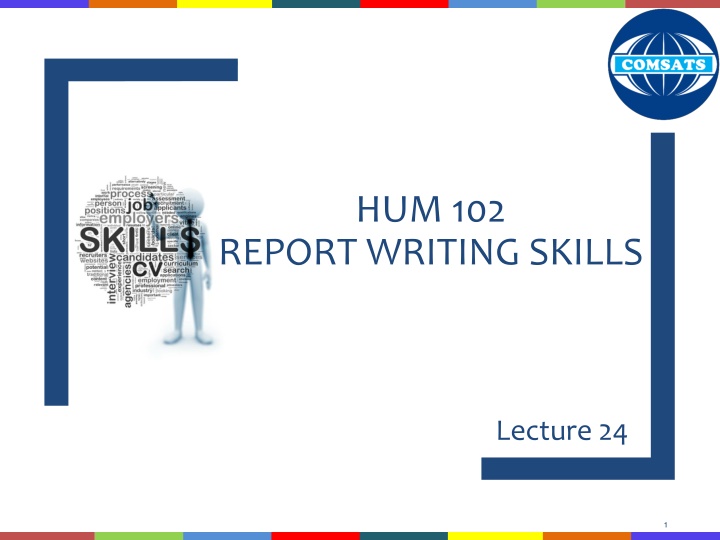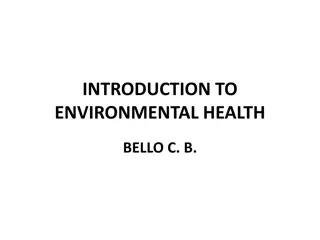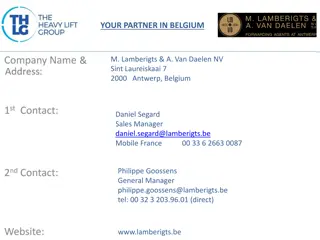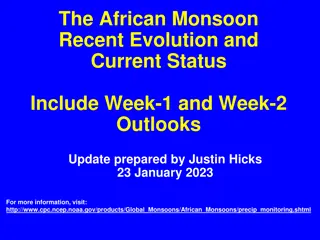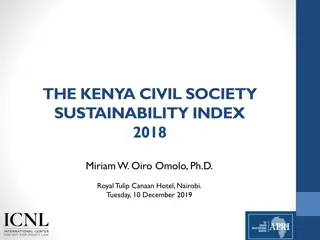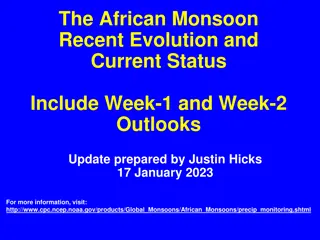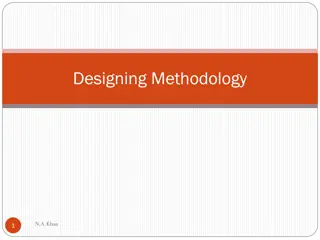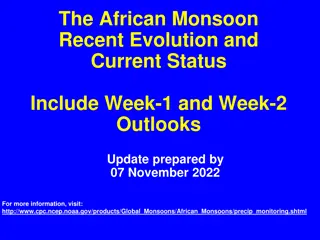Research Methodology in Environmental Health Practice - West Africa
This paper delves into the research methodology in environmental health practice in West Africa, focusing on the steps, definitions, importance, and parts involved. It highlights the significance of methodology in generating data, interpreting findings, and ensuring consistency in study practices. Survey, descriptive, and analytic research designs are explored with a special emphasis on descriptive studies and cross-sectional surveys.
Download Presentation

Please find below an Image/Link to download the presentation.
The content on the website is provided AS IS for your information and personal use only. It may not be sold, licensed, or shared on other websites without obtaining consent from the author.If you encounter any issues during the download, it is possible that the publisher has removed the file from their server.
You are allowed to download the files provided on this website for personal or commercial use, subject to the condition that they are used lawfully. All files are the property of their respective owners.
The content on the website is provided AS IS for your information and personal use only. It may not be sold, licensed, or shared on other websites without obtaining consent from the author.
E N D
Presentation Transcript
HUM 102 REPORT WRITING SKILLS Lecture 24 1
Previous Lecture Basics of Plagiarism Quotations Citations Paraphrasing Tips to Avoid Plagiarism 2
Referencing Style Citation Documentation of original source Street address for the quote Reference to a published/ unpublished source Goes parallel with your writing Not to be overlooked Mark all the sites for citations 3
Referencing Style What needs to be documented? When exact words or a unique phrases have been copied. When ideas presented in a book, magazine, newspaper, web page, TV program, letter, advertisement or any other medium have been incorporated in work. When any diagrams, illustrations, charts, pictures or other visual material has been reprinted. When information is gained through interviewing or conversing with another person, face to face, on phone or in writing. When any electronically available material including images, audio or video has been reused. 4
Referencing Style Why must we cite? To acknowledge and give credit to sources of words, ideas, diagrams, illustrations, quotations borrowed, or any materials summarized or paraphrased. To show that you are respectfully borrowing other people s ideas, not stealing them, i.e., to prove that you are not plagiarizing. To enhance the credibility of your research. By giving the readers an opportunity to check out your sources for accuracy, you inspire reader confidence. 5
Referencing Style HEC s Plagiarism Policy In the special meeting of the commission held on 14th of April 2007, the following was decided: o To preserve academic honesty and sanctity of the degrees awarded by the Universities and Degree Awarding Institutes in Pakistan, HEC will have a zero tolerance policy towards any kind of Plagiarism. 6
Referencing Style What need not to be documented? Writing your own lived experiences, your own observation and insight, your own thoughts and your own conclusions about a subject. When you are writing up your own obtained results through lab or field experiments. When you use your own art work, digital photographs, audio and video. When you use commonknowledge - things like folklore, common sense observations, myths, urban legends and historical events (but not historical documents). 7
Referencing Style Methods of Citation Parenthetical References Footnotes Endnotes 8
Referencing Style Footnotes Place a superscript number after the last word of the quotation. Place the same superscript number at the beginning of the Footnote at the bottom of the same page where the citation occurs. Example: o In traditional British East Africa, there are certain social and cultural restrictions for young females.6 o [6] Sigmund Freud, Totem and Taboo (New York: Random, 1918) 17. In your work cited page, you write: o Freud, Sigmund. Totem and Taboo. New York: Random, 1918. 9
Referencing Style Endnotes Endnotes are written in the same way as footnotes. The main difference is that footnotes are placed numerically at the foot of the very same page where direct references are made, while Endnotes are placed numerically at the end of the essay on a separate page entitled End notes or notes. Example: o The World Book Encyclopedia defines Taboo as an action, object, person, or place forbidden by law or culture. 1 o [1] Alan Dundes, "Taboo," World Book Encyclopedia. 2000 ed. In your work cited page, you write: o Dundes, Alan. "Taboo." World Book Encyclopedia. 2000 ed. 10
Referencing Style Parenthetical references It is the simplest way to cite sources. The author's last name and page number(s) are placed in parentheses in the text to give credit to sources. Example: o In their Preface, the authors point out that "Learning Hypertext Markup Language (HTML) and Extensible Hypertext Markup Language (XHTML) is like learning any new language, computer or human" (Musciano and Kennedy xi). In your bibliography or work cited page you write o Musciano, Chuck, and Bill Kennedy. HTML and XHTML: The Definitive Guide. 4th ed. Sebastopol, CA: O'Reilly, 2000. 11
Referencing Style Referencing Styles APA MLA Oxford Harvard Chicago 12
Referencing Style Modern Language Association (MLA) [1/4] Direct Quotes: Less than 4 lines are placed within a paragraph enclosed within quotation marks Mention the author s last name and page number Joseph Conrad writes of the company manager in Heart of Darkness, He was obeyed, yet he inspired neither love nor fear, nor even respect (87) The red tree vole is a crucial part of the spotted owl's diet (Moone 15) 13
Referencing Style Modern Language Association (MLA) [2/4] Block Quotes: quotations longer than 4 lines Placed separately indented by 1 inch At the conclusion of Lord of the Flies, Ralph and the other boys realize the horror of their actions: o The tears began to flow and sobs shook him. He gave himself up to them now for the first time on the island; great, shuddering spasms of grief that seemed to wrench his whole body. His voice rose under the black smoke before the burning wreckage of the island; and infected by that emotion, the other little boys began to shake and sob too. (186) 14
Referencing Style Modern Language Association (MLA) [3/4] Indirect Quote: First suggestion is that try to cite directly Name the primary source in your original phrase Include the secondary source in parentheses with qtd. in (quoted in) Include indirect source in work cited list. For example: o Jackson stated that... (qtd. in Johns 14) 15
Referencing Style Modern Language Association (MLA) [4/4] In case of 2-3 authors: o Studies have shown that more and more teachers are changing careers after their first year of teaching. (Posamentier, Jaye, and Krulik 55) In case of more than 3 authors: o Stutts et. al. argue that language development may also impact development in related parts of the brain (339) 16
Referencing Style Works Cited List [1/2] In case of a Book: Lastname, Firstname. Title of Book. City: Publisher, Year. Format o Picoult, Jodi. The Storyteller: A Novel. New York: Emily Bestler, 2013. Print o Posamentier, Alfred S., Daniel Jaye, and Stephen Krulik. Exemplary Practices for Secondary Math Teachers. o Alexandria: Assn. for Supervision and Curriculum Development, 2007. Print. Article in a Reference Book: Brown, William F. Collie. Encyclopedia Americana. Deluxe Library ed. 1997. Print. In case of an E-Book: Rowley, Hazel. Franklin and Eleanor: An Extraordinary Marriage. New York: Farrar, 2010. Kindle file 17
Referencing Style Works Cited List [2/2] Lastname, Firstname. Article Title. Journal Title volume. issue (year): page numbers. Database name if applicable. Web. Day month year accessed In case of Online Magazine Article: Duplet, Franc. How to Duplicate the Success of a Business. Successful Jobs Oct. 2003: 55-58. General Business File. Web. 28 Dec. 2008 In case of Online Journal Article: Liller, Karen D. Let's Sell Health. Journal of School Health 75.5 (2005): 187-188. Academic Search Premier. Web. 2009 In case of Online Newspaper Article: Robs, Jake. 10 Tips for Negotiating a House Offer. Miami Herald 14 June 2008: C1+. America's Newspapers. Web. 9 Nov. 2008 18
Referencing Style What is APA? The American Psychological Association (APA) citation style is the most commonly used format for manuscripts in the social sciences. Author-Date Citation System 19
Referencing Style Manuscript format [1/2] You should: o Use a serif typeface, as New Times Roman, for the text. Use a sans serif typeface, as Ariel, for the figure labels. o Double-space the entire manuscript, between body text, titles, headings, block quotations , reference list and figure captions. o Indent first line of every para one -half inch. o Align text to left-hand margin, leaving a rough right hand margin. 20
Referencing Style Manuscript format [2/2] You should: o Print on standard-sized paper (8.5 x11 ) (Letter) o Use 1 margins on all sides o Use 12 pt. Times New Roman or a similar font o Include a page header (running head) in the upper left-hand of every page and a page number in the upper right-hand side of every page o Running head be less than 50 characters 21
Referencing Style Page 1: Title Page Running head: capitalized, top left hand corner Page number: top right-hand corner Full title of paper: centered, upper and lower case letters (<12 words) Name of author: centered Author s affiliation: centered Author s note with more info about affiliation: bottom of page Double spaced 22
Referencing Style Page 1: Title Page Sample Page header: (use Insert Page Header) title flush left + page number flush right. Title: (in the upper half of the page, centered) name (no title or degree) + affiliation (university, etc.) 23
Referencing Style Page 2: Abstract Left aligned and justified 150-250 words For keywords, first indent and then italicize 24
Referencing Style Page 2: Abstract Sample Page header: do NOT include Running head: Abstract: Left aligned, at the top of the page Write a 150- to 250- word summary of your paper in an accurate, concise, and specific manner. 25
Referencing Style Page 2: Main Body (Text) Title of the paper at the top of the page Double-spacing with all sections following each other without a break Identify the sources you use in the paper in parenthetical in-text citations 26
Referencing Style In-text Citations: Basics This means that the author's last name and the year of publication for the source should appear in the text, e.g., (Ahmad, 2016). In-text citations help readers locate the cited source in the References section of the paper. Whenever you use a source, provide in parenthesis: the author s name and the date of publication o for quotations and close paraphrases, provide the author s o name, date of publication, and a page number 27
Referencing Style In-text Citations: Formatting Quotations When quoting, introduce the quotation with a signal phrase. Make sure to include the author s name, the year of publication, the page number, but keep the citation brief do not repeat the information. For example: o Caruth (1996) states that a traumatic response frequently entails a delayed, uncontrolled repetitive appearance of hallucinations and other intrusive phenomena (p.11). o A traumatic response frequently entails a delayed, uncontrolled repetitive appearance of hallucinations and other intrusive phenomena (Caruth, 1996, p.11). 28
Referencing Style In-text Citations: Formatting a Summary or Paraphrase Provide the author s last name and the year of publication in parenthesis after a summary or a paraphrase. For example: o Though feminist studies focus solely on women s experiences, they err by collectively perpetuating the masculine-centered impressions (Fussell, 1975). 29
Referencing Style In-text Citations: Formatting a Summary or Paraphrase Several authors with different dates: Include the authors name in a signal phrase followed by the year of publication in parenthesis. For example: o Recently, the history of warfare has been significantly revised by Higonnet et al. (1987), Marcus (1989), and Raitt and Tate (1997) to include women s personal and cultural responses to battle and its resultant traumatic effects. 30
Referencing Style In-text Citations: Signal Words/Phrases Introduce quotations with signal phrases, e.g. o According to X. (2008), (p. 3). o X. (2008) argued that (p. 3). Use such signal verbs as: o acknowledged, contended, maintained, responded, reported, argued, concluded, etc. Use the past tense or the present perfect tense of verbs in signal phrases 31
Referencing Style In-text Citations: A Work with Two Authors When citing a work with two authors, use and in between authors name in the signal phrase yet & between their names in parenthesis. o According to feminist researchers Raitt and Tate (1997), It is no longer true to claim that women s responses to the war have been ignored (p. 2). o Some feminists researchers question that women s responses to the war have been ignored (Raitt & Tate, 1997, p. 2). 32
Referencing Style In-text Citations: A Work with Three to Five Authors When citing a work with three to five authors, identify all authors in the signal phrase or in parenthesis. o (Harklau, Siegal, and Losey, 1999) In subsequent citations, only use the first author s last name followed by et al. in the signal phrase or in parentheses. o (Harklau et al., 1993) 33
Referencing Style In-text Citations: A Work with Six and More Authors When citing a work with six and more authors, identify the first author's name followed by et al. o Smith et al. (2006) maintained that o (Smith et al., 2006) 34
Referencing Style In-text Citations: Organization When citing an organization, mention the organization the first time when you cite the source in the signal phrase or the parenthetical citation. o The data collected by the Food and Drug Administration (2008) confirmed that If the organization has a well-known abbreviation, include the abbreviation in brackets the first time the source is cited and then use only the abbreviation in later citations. o Food and Drug Administration (FDA) confirmed FDA s experts tested 35
Referencing Style In-text Citations: Same Last Name or Same Author When citing authors with the same last names, use first initials with the last names. o (B. Kachru, 2005; Y. Kachru, 2008) When citing two or more works by the same author published in the same year, use lower-case letters (a, b, c) with the year of publication to order the references. o Smith s (1998a) study of adolescent immigrants 36
Referencing Style In-text Citations: Personal Communication When citing interviews, letters, e-mails, etc., include the communicator s name, the fact that it was personal communication, and the date of the communication. Do not include personal communication in the reference list. o A. P. Smith also claimed that many of her students had difficulties with APA style (personal communication, November 3, 2002). o (E. Robbins, personal communication, January 4, 2001). 37
Referencing Style In-text Citations: Electronic Sources When citing an electronic document, whenever possible, cite it in the author-date style. If electronic source lacks page numbers, locate and identify paragraph number/paragraph heading. o According to Smith (1997), ... (Mind over Matter section, para. 6). 38
Referencing Style Reference Page Center the title (References) at the top of the page. Do not bold it. Double-space reference entries Flush left the first line of the entry and indent subsequent lines Order entries alphabetically by the author s surnames 39
Referencing Style Reference Basics [1/2] Invert authors names (last name first followed by initials: Smith, J.Q. ) Alphabetize reference list entries the last name of the first author of each work Capitalize only the first letter of the first word of a title and subtitle, the first word after a colon or a dash in the title, and proper nouns. Do not capitalize the first letter of the second word in a hyphenated compound word. 40
Referencing Style Reference Basics [2/2] Capitalize all major words in journal titles Italicize titles of longer works such as books and journals Do not italicize, underline, or put quotes around the titles of shorter works such as journal articles or essays in edited collections 41
Referencing Style Making the References List APA is a complex system of citation. When compiling the reference list, the strategy below might be useful: Identify the type of source: Is it a book? A journal article? A webpage? Find a sample of citing such source in the textbook or in OWL APA Guide: http://owl.english.purdue.edu/owl/resource/560/01/ Mirror the sample Make sure that the entries are listed in the alphabetical order and the subsequent lines are indented (Recall References: Basics) 42
Referencing Style APA Tables Label tables with an Arabic numeral and provide a title. The label and the title appear on separate lines above the table, flush-left and single-spaced. Cite a source in a note below the table. Table 1 : Internet users in Europe Country Regular users France XYZ Note: The data are adapted from The European Union and Russia (2007). Retrieved from http://epp.eurostat.ec.europa.eu 43
Referencing Style Book: Format & Example Author s last name, first initial. (Publication date). Book title. Additional information. City of publication: Publishing company. o Allen, T. (1974). Vanishing wildlife of North America. Washington, D.C.: National Geographic Society. o Boorstin, D. (1992). The creators: A history of the heroes of the imagination. New York: Random House. 44
Referencing Style Encyclopedia &Dictionary: Format & Example Author s last name, first initial. (Date). Title of Article. Title of Encyclopedia (Volume, pages). City of publication: Publishing company. o Bergmann, P. G. (1993). Relativity. In the new encyclopedia britannica (Vol. 26, pp. 501-508). Chicago: Encyclopedia Britannica. o Merriam-Webster's collegiate dictionary (10th ed.). (1993). Springfield, MA: Merriam-Webster. 45
Referencing Style Magazine and Newspaper Article: Format & Example Author's last name, first initial. (Publication date). Article title. Periodical title, volume number(issue number if available), inclusive pages. pp or p without volume number/ in case of newspapers in APA Harlow, H. F. (1983). Fundamentals for preparing psychology journal articles. Journal of Comparative and Physiological Psychology, 55, 893-896. Henry, W. A., III. (1990, April 9). Making the grade in today's schools. Time, 135, 28-31. Trillin, C. (1993, February 15). Culture shopping. New Yorker, pp. 48-51. 46
Referencing Style Website or Webpage: Format & Example [1/2] In case of Online Periodical: Author's name. (Date of publication). Title of article. Title of Periodical, volume number, Retrieved month day, year, from full URL In case of Online Document: Author's name. (Date of publication). Title of work. Retrieved month day, year, from full URL 47
Referencing Style Website or Webpage: Format & Example [2/2] Devitt, T. (2001, August 2). Lightning injures four at music festival. The Why? Files. Retrieved January 23, 2002, from http://whyfiles.org/137lightning/index.html Dove, R. (1998). Lady freedom among us. The Electronic Text Center. Retrieved June 19, 1998, from Alderman Library, University of Virginia website: http://etext.lib.virginia.edu/subjects/afam.html Note: If a document is contained within a large and complex website (such as that for a university or a government agency), identify the host organization and the relevant program or department before giving the URL for the document itself. Precede the URL with a colon. Fredrickson, B. L. (2000, March 7). Cultivating positive emotions to optimize health and well-being. Prevention & Treatment, 3, Article 0001a. Retrieved November 20, 2000, from http://journals.apa.org/prevention/volume3/pre0030001a.html GVU's 8th WWW user survey. (n.d.). Retrieved August 8, 2000, from http://www.cc.gatech.edu/gvu/usersurveys/survey1997-10/ Health Canada. (2002, February). The safety of genetically modified food crops. Retrieved March 22, 2005, from http://www.hcsc.gc.ca/english/protection/biologics_genetics/gen_mod_foods/genmodebk.html Hilts, P. J. (1999, February 16). In forecasting their emotions, most people flunk out. New York Times. Retrieved November 21, 2000, from http://www.nytimes.com 48
Referencing Style Additional APA Resources The Purdue OWL http://owl.english.purdue.edu Purdue Writing Lab @ HEAV 226 Composition textbooks Publication Manual of the American Psychological Association, 6th ed. APA s website http://www.apastyle.org https://www.sciencebuddies.org/science-fair-projects/science- fair/writing-a-bibliography-apa-format 49
Referencing Style Citation Made Easy Microsoft Word Citefast BibMe Zotero 50
